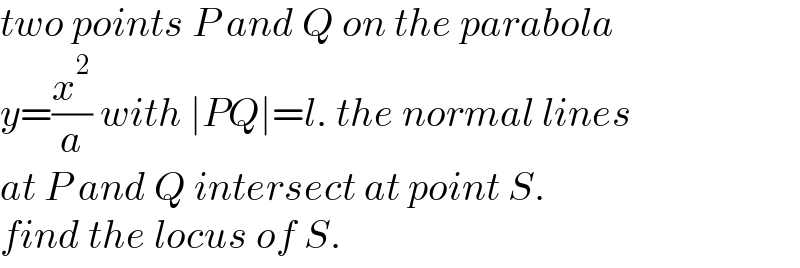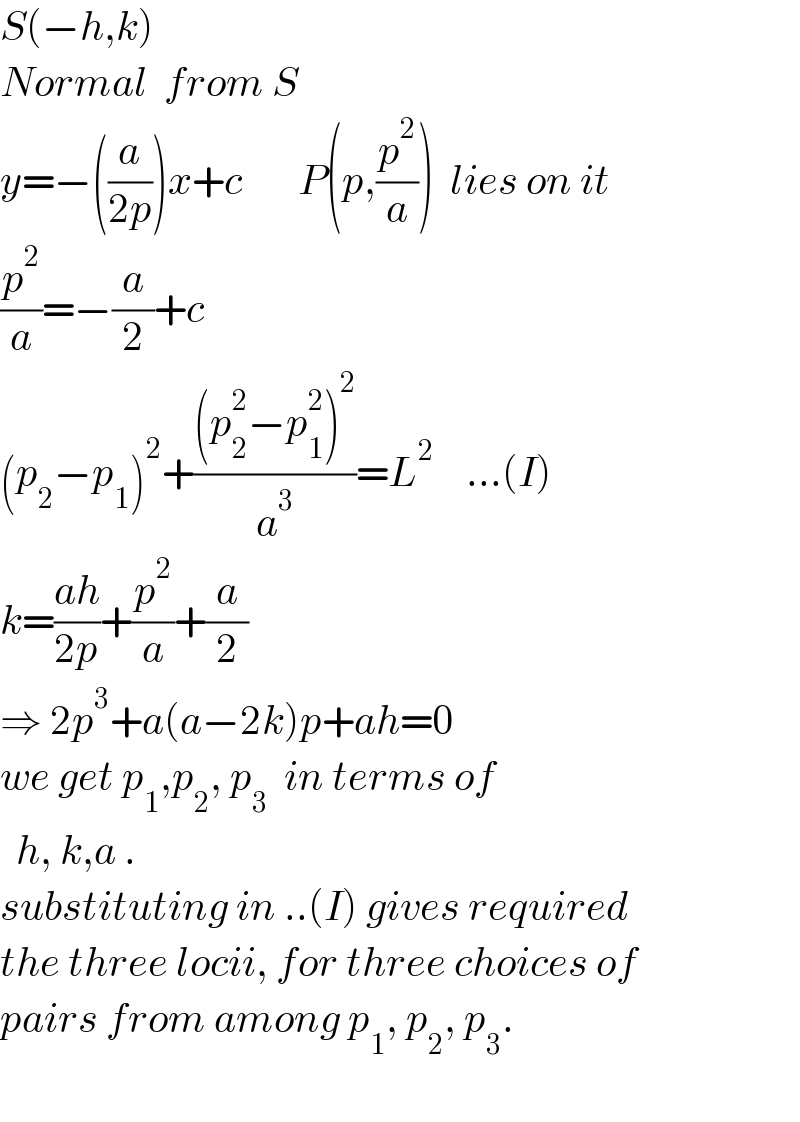
Question and Answers Forum
Question Number 164728 by mr W last updated on 21/Jan/22

Commented by mr W last updated on 21/Jan/22

Answered by ajfour last updated on 21/Jan/22

Commented by mr W last updated on 21/Jan/22

Answered by mr W last updated on 21/Jan/22

Commented by mr W last updated on 23/Jan/22

Commented by mr W last updated on 22/Jan/22

Commented by mr W last updated on 21/Jan/22
![say P(p, (p^2 /a)), Q(q, (q^2 /a)) tan φ=((2p)/a) tan ϕ=((2q)/a) (q−p)^2 +((q^2 /a)−(p^2 /a))^2 =l^2 (q−p)^2 [1+(((p+q)^2 )/a^2 )]=l^2 [(q+p)^2 −4pq][1+(((p+q)^2 )/a^2 )]=l^2 let u=p+q, v=pq (u^2 −4v)(1+(u^2 /a^2 ))=l^2 ⇒v=(1/4)(u^2 −((a^2 l^2 )/(a^2 +u^2 ))) eqn. of PS: y=(p^2 /a)−(a/(2p))(x−p) y=(p^2 /a)+(a/2)−((ax)/(2p)) eqn. of QS: y=(q^2 /a)+(a/2)−((ax)/(2q)) say intersection point S(x_s ,y_s ) (p^2 /a)+(a/2)−((ax_s )/(2p))=(q^2 /a)+(a/2)−((ax_s )/(2q)) (p^2 /a)−((ax_s )/(2p))=(q^2 /a)−((ax_s )/(2q)) x_s =−((2(q+p)pq)/a^2 ) ⇒x_s =−((2uv)/a^2 ) 2y_s =((p^2 +q^2 )/a)+a−ax_s ((1/(2p))+(1/(2q))) y_s =(a/2)+((p^2 +q^2 )/(2a))−((a(p+q)x_s )/(4pq)) y_s =(a/2)+(((p+q)^2 −pq)/a) ⇒y_s =(a/2)+((u^2 −v)/a) taking u as parameter we get the eqn. of locus of point S: { ((x=−((2uv)/a^2 ))),((y=(a/2)+((u^2 −v)/a))) :} with v=(1/4)(u^2 −((a^2 l^2 )/(a^2 +u^2 ))) with u given, p, q are roots of z^2 −uz+(1/4)(u^2 −((a^2 l^2 )/(a^2 +u^2 )))=0 ⇒p,q=(1/2)(u∓((al)/( (√(a^2 +u^2 )))))](Q164771.png)
Commented by mr W last updated on 21/Jan/22

Commented by mr W last updated on 21/Jan/22

Commented by ajfour last updated on 21/Jan/22

Commented by Tawa11 last updated on 21/Jan/22

Answered by ajfour last updated on 23/Jan/22

Commented by ajfour last updated on 23/Jan/22

